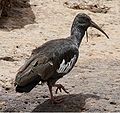| Image | Scientific name | Common name | Distribution |
|---|
 | Bostrychia carunculata | Wattled ibis | Ethiopia |
 | Bostrychia hagedash | Hadada ibis | Sudan, Burundi, Ethiopia, Senegal, Uganda, Tanzania, Gabon, Democratic Republic of Congo, Cameroon, Gambia, Kenya, Somalia, Lesotho, Eswatini, Botswana, Mozambique, Zimbabwe and South Africa. |
 | Bostrychia olivacea | Olive ibis | Cameroon, Democratic Republic of the Congo, Republic of the Congo, Côte d'Ivoire, Gabon, Ghana, Kenya, Liberia, Nigeria, Sierra Leone, Zaire, Tanzania and São Tomé and Príncipe Island |
 | Bostrychia bocagei | São Tomé ibis | São Tomé |
 | Bostrychia rara | Spot-breasted ibis | Angola, Cameroon, Central African Republic, the Republic of the Congo, the Democratic Republic of the Congo, Ivory Coast, Equatorial Guinea, Gabon, Ghana, Guinea, Liberia, Nigeria, Sierra Leone, and Uganda |
|







